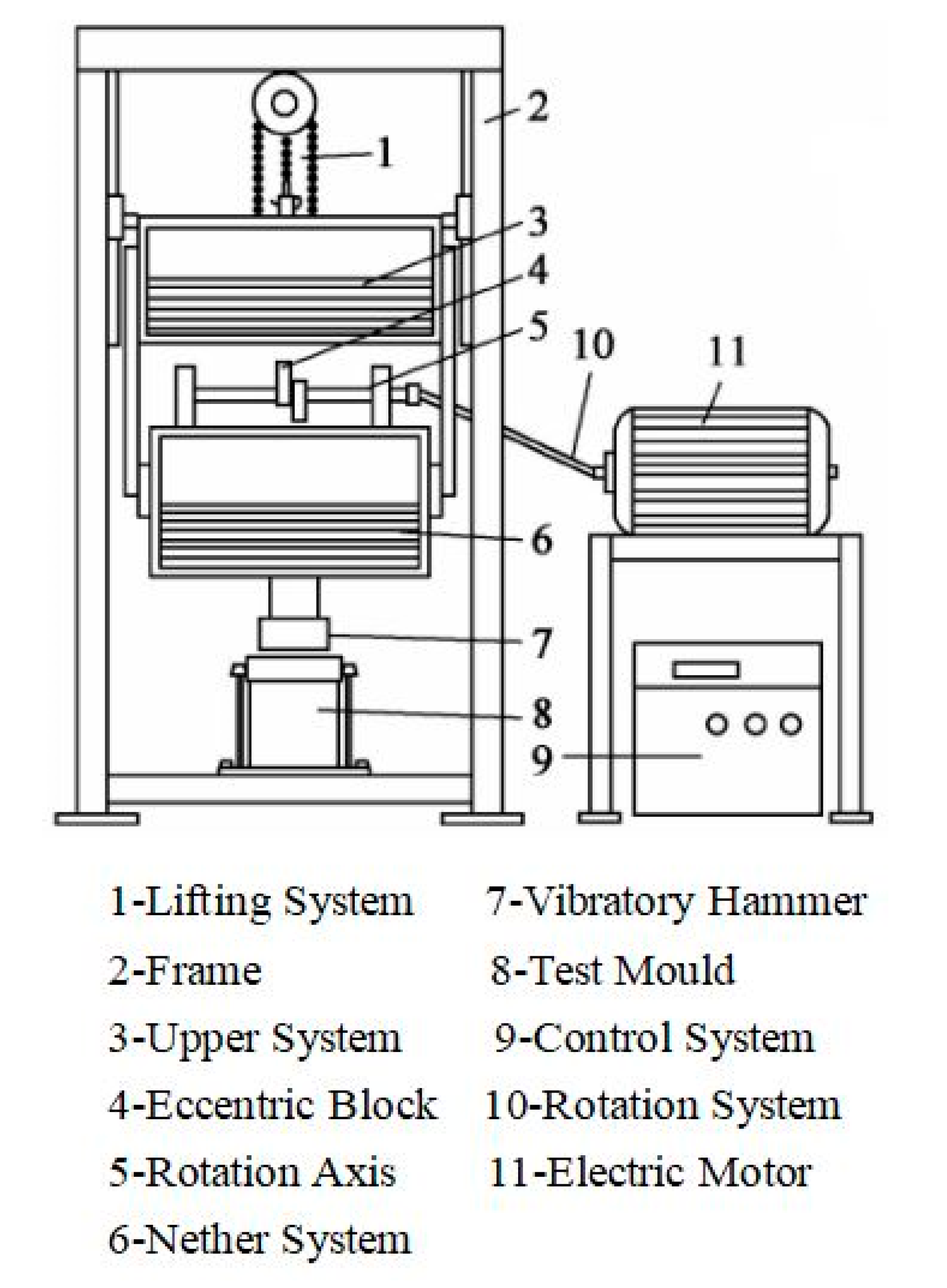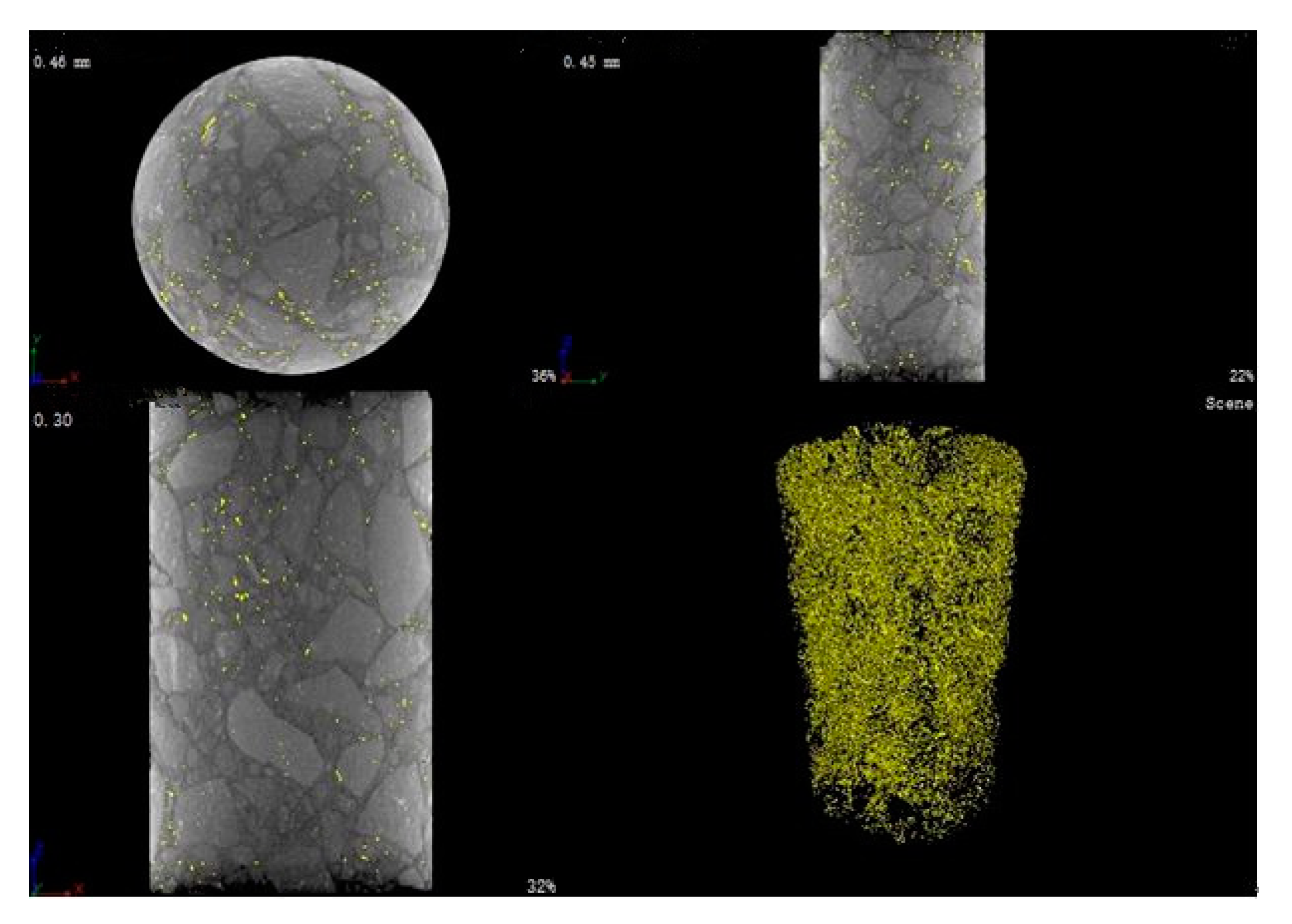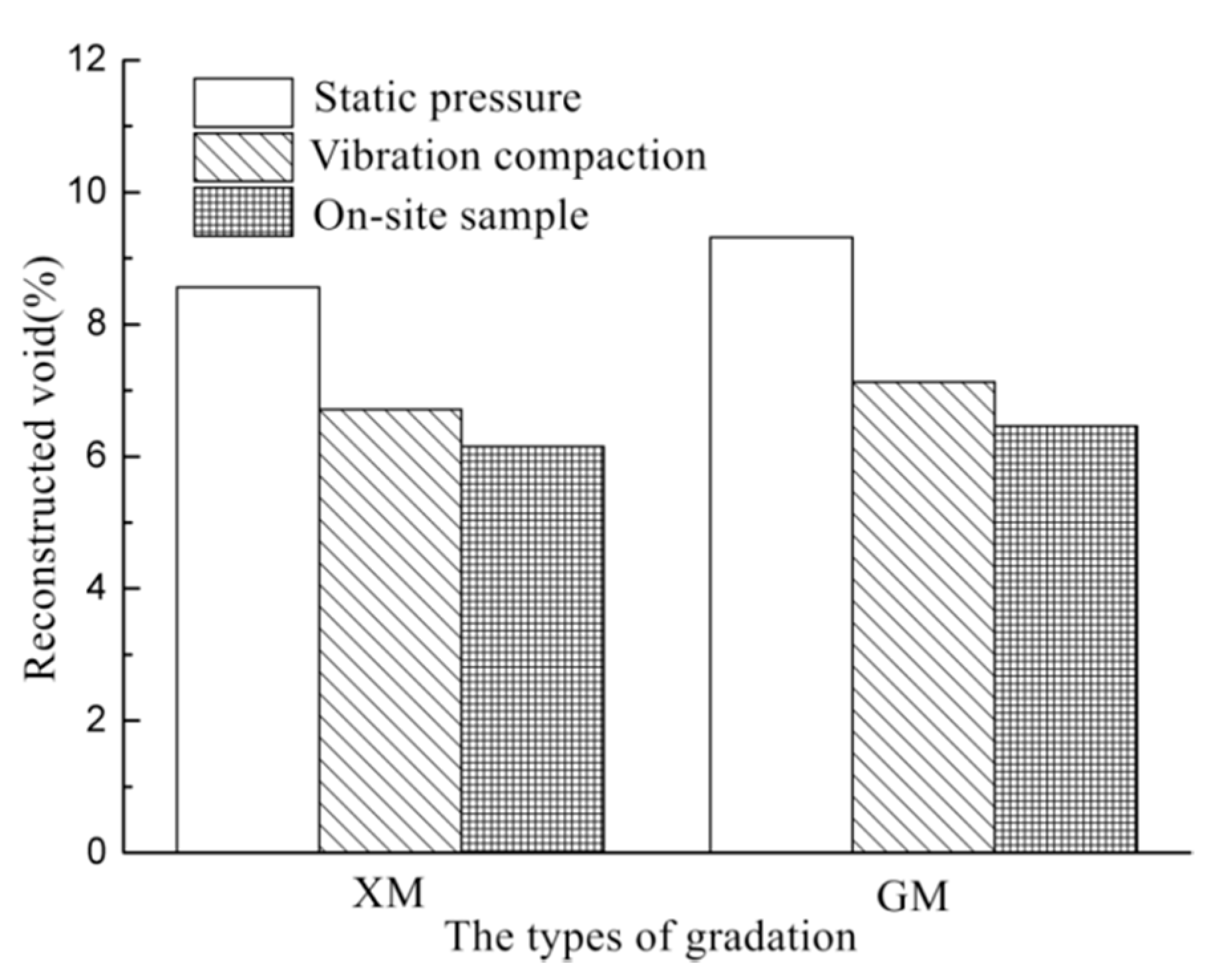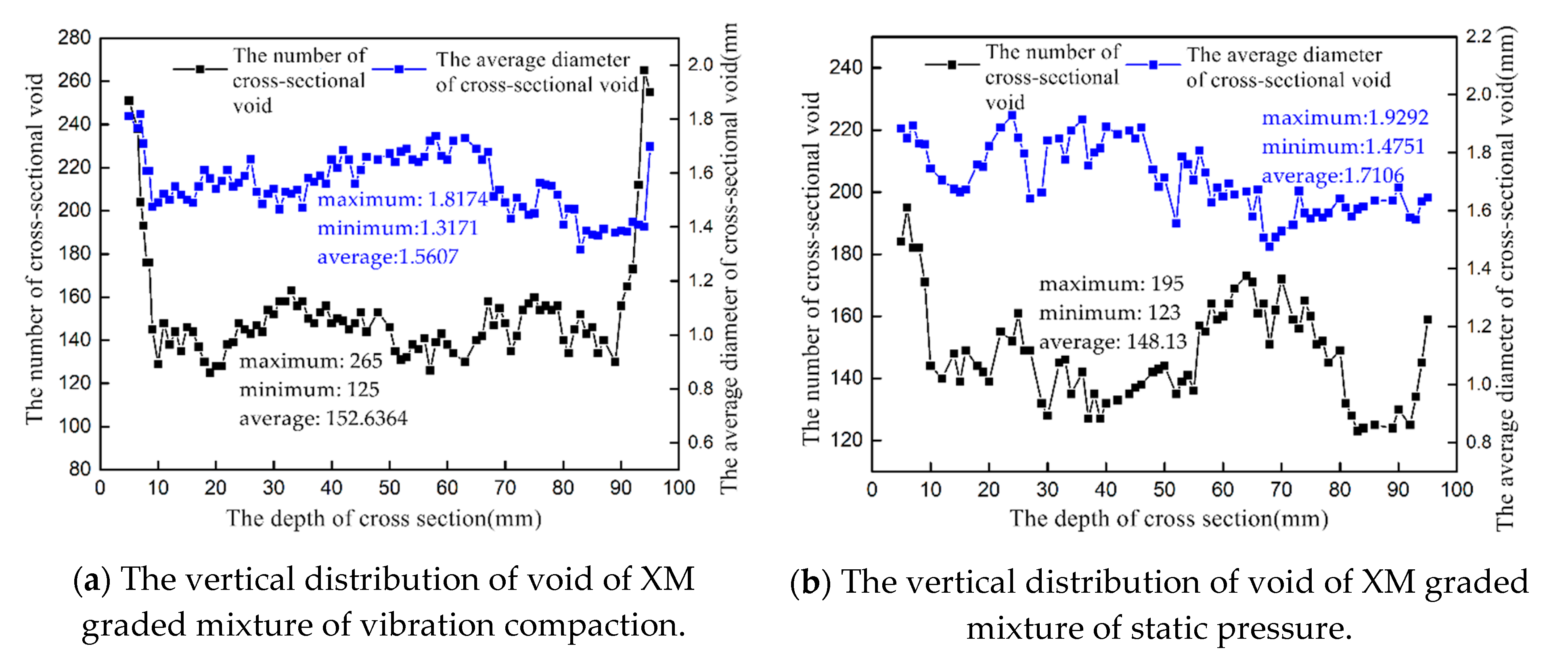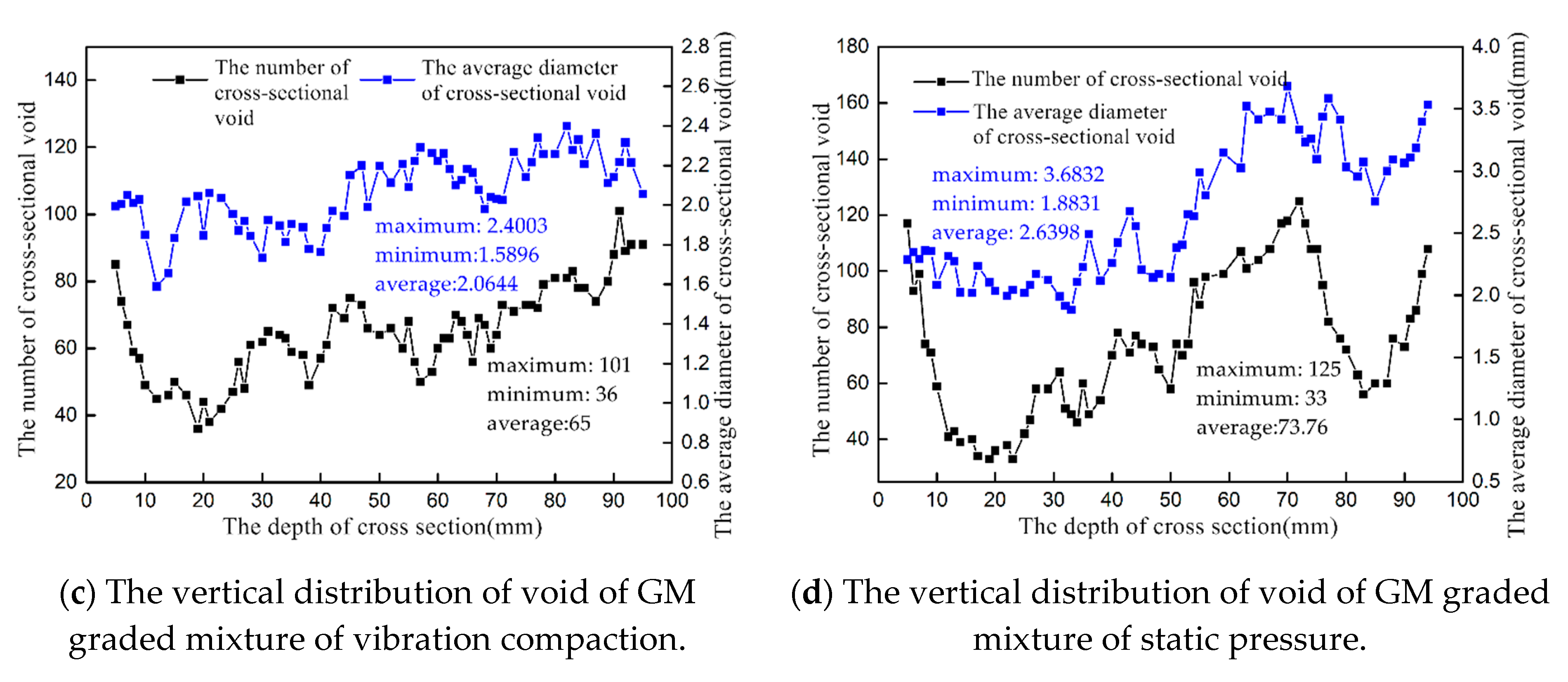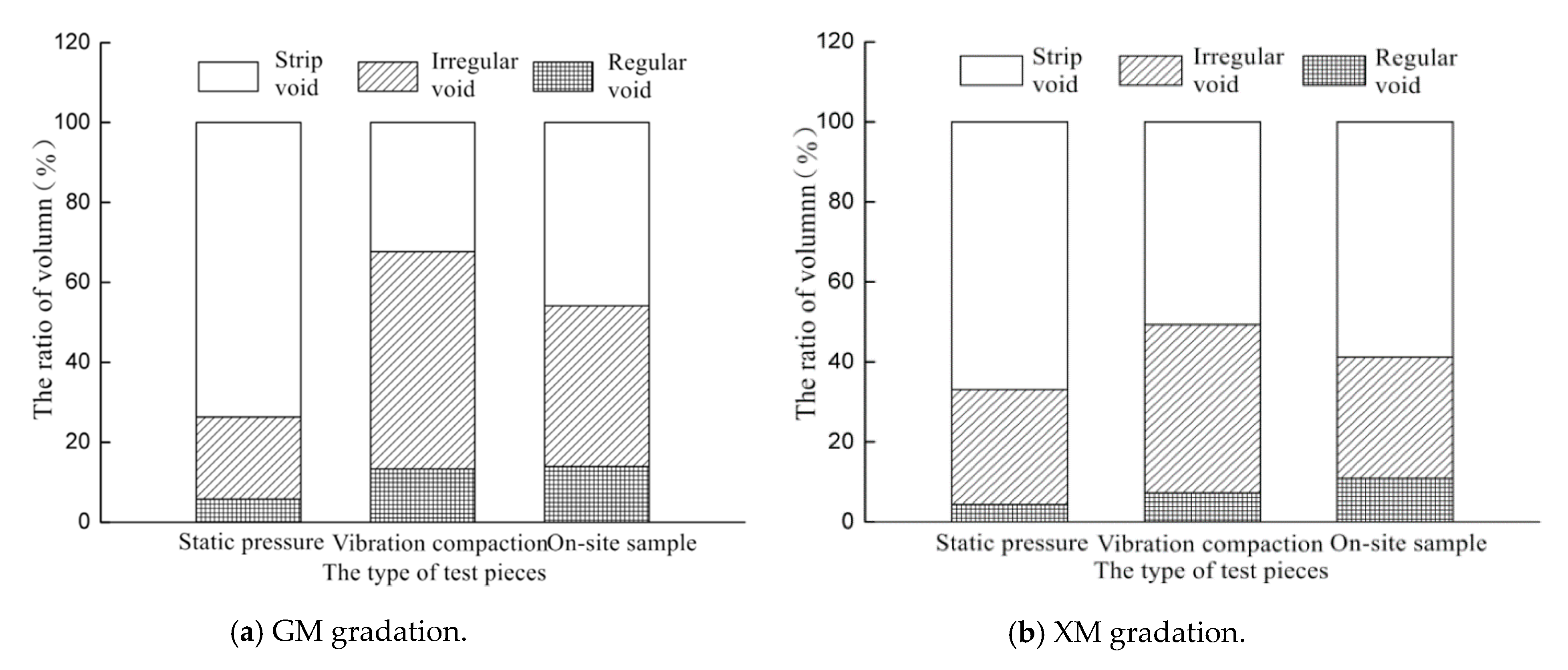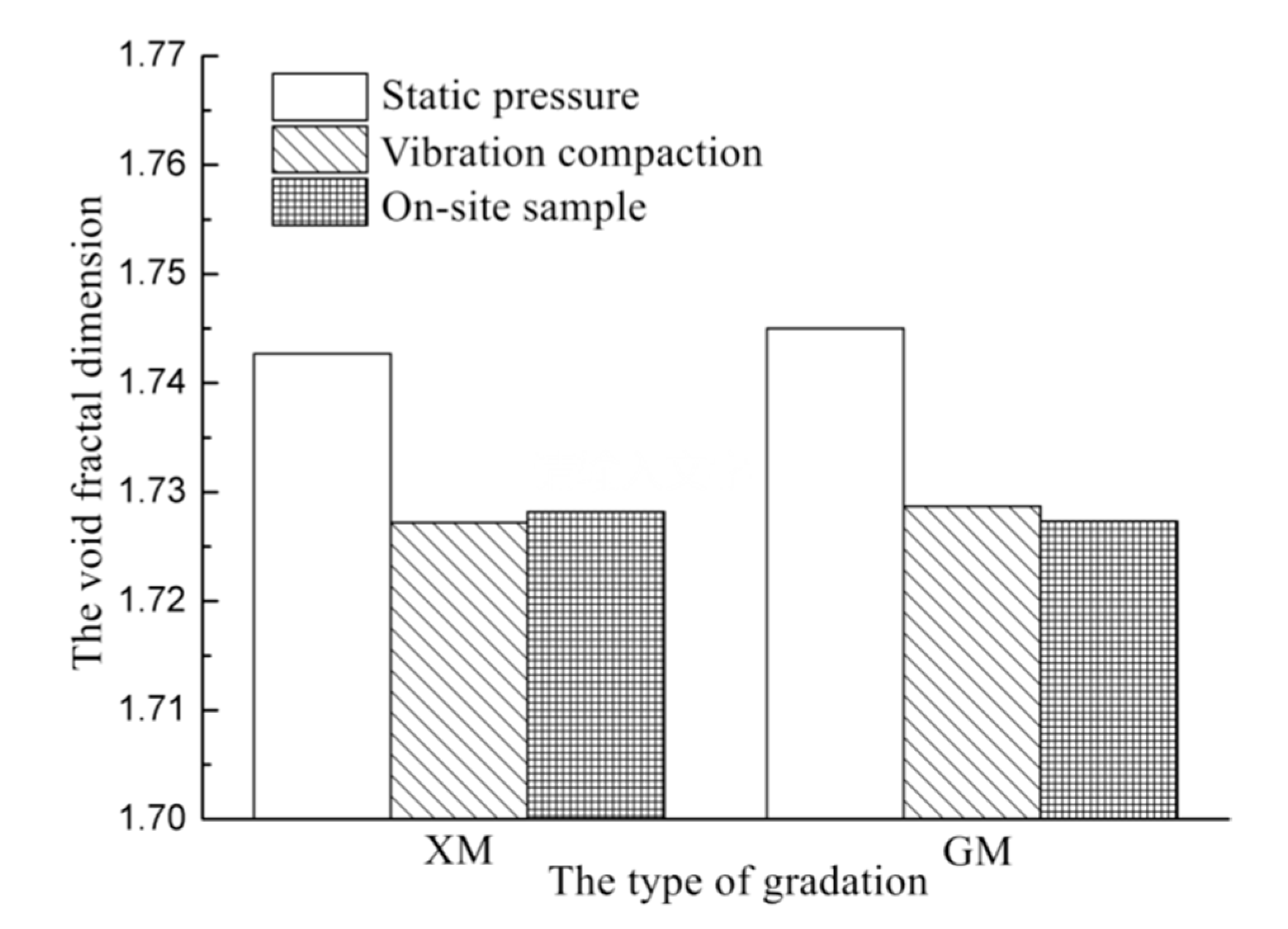It inevitably forms some volume of void when molding cement stabilized macadam mixture. Although the proportion of the void is small, void has a certain influence on the mechanical properties and anti-freezing performance of the mixture. Therefore, studying the internal void distribution characteristics of the mixture is of great significance for studying road performance and evaluating the uniformity. The internal void distribution characteristics include the size, distribution of number and spatial, distribution of void shape, research on the self-similarity, and so on. The specific parameters are the number of cross-sectional voids, the average diameter of cross-sectional void, the parameter of void shape, and the fractal dimension of void. Based on this, this paper analyzes the internal void distribution characteristics of cement stabilized macadam mixture with two different molding methods and on-site sample.
3.3.1. Reconstructed Void Measurement
In this paper, three-dimensional reconstruction of cement stabilized macadam images obtained by X-ray CT were carried out using VG Studio Max 2.2 software of Kunzhong Electrothermal Technology Co. LTD, Suzhou, Jiangsu, China. The surface measurement, defect detection, volume analysis, and other modules in the software were used to obtain the internal void information of the mixture, as shown in
Figure 3. The void information is extracted by adjusting the gray threshold, and unnecessary information is eliminated according to the actual image. Finally, the void of three-dimensional reconstructed specimens is obtained, which is called “reconstructed void” in this paper. Some studies [
18] have proved that the reconstructed void is close to the “measured void” measured by experiments, and can well reflect the size of the void inside the mixture. The extracted void results of reconstructed specimens are shown in
Figure 4 and
Table 10.
As can be seen from the reconstructed void results in
Table 10 and
Figure 4, the size of void has the following relationship: The static pressure specimens > vibration specimens > on-site sample, and the latter two are much closer. The ratio of reconstructed void results is 1.39 and 1.44 under the static pressure specimens and on-site sample, but is 1.09 and 1.10 under the vibration compacted specimens and on-site sample. The reason can be analyzed by considering that the vibration compaction has a greater compaction work compared with static pressure, and the compressed materials can achieve rearrangement because they have a greater force and displacement under greater compaction work. The movement of large particles also provides the possibility for cement mortar to fill void effectively. Therefore, the change of the molding method from static pressure to vibration compaction also changes the arrangement mode of aggregate, thus affecting the volume parameters after molding. In addition, the aggregate particles can be more tightly packed in the rolling process of the vibration roller due to a lack of mold limitation in the on-site compaction, and the cement mortar can fully fill the skeleton void molded by coarse aggregate, so the on-site sample has a lower void ratio.
On the other hand, the void ratio of GM gradation mixed was 0.76% higher than that of XM type under the static pressure condition, while the void between the two-gradation mixed with the vibration method was small. This demonstrates that the bulk aggregate can move more freely to form an effective embedded structure in the process of the vibration compaction, which is conducive for the second or even finer aggregate and cement to fill void.
3.3.2. The Study on Vertical Distribution of Void
The images obtained by X-ray CT scan are two-dimensional images. Some studies have shown that the finite information of two-dimensional images can reflect the three-dimensional void information of the mixture when the number of scanned sections is greater than 32, with a guarantee rate of 95% and an error control of 2.5%. In this paper, for each specimen, 90 vertical cross-section images were selected for data collection after removing the upper and lower 5 mm images of the end sections. The results show that they could meet the research requirements.
The size and number of voids of each section of GM and XM graded mixture specimens were calculated to study the uniformity of the vertical distribution of the void parameters of mixture. The specific parameters include [
19]: The number and average diameter of cross-sectional void, where the diameter of cross-sectional void is the diameter of the equivalent circle of the average void of each section. The mathematical expression is as follows:
where
A is the total area of the void extracted from a cross-sectional image of the mixture, and
N is the number of voids extracted from a cross-sectional image of the mixture.
As seen from
Figure 5, the size and number of voids of the specimens of GM and XM graded cement stabilized macadam mixture molded by static pressure and vibration compaction are generally characterized by uneven longitudinal distribution. The specimens can be divided into “top”, “middle”, and “bottom” in depth. According to different molding methods graded by GM and XM and on-site sample, the curve shape of the number of cross-sectional voids shows the characteristics of “high at both ends and low at middle”. This is because the number and size of void of a top and bottom mixture is large in the process of molding the cement stabilized macadam mixture due to the disturbance of the molding and cutting machine on the specimens.
Different molding methods have a greater influence on the number and size of the void of mixture. The number and equivalent diameter of void of staticpressure specimens is larger than vibration specimens. And the two curves corresponding to staticpressure specimens show large fluctuations, which fluctuates with the depth of specimens, and there is a phenomenon that the distribution of top and bottom is obviously asymmetric. The reason is that traditional static pressure specimens are close-grained by the static pressure between aggregates, so the moving range of aggregates is limited, and the fine aggregate and binder cannot fill the void well. In particular, for GM gradation, the static friction force of the static pressure on coarse aggregate often causes the original aggregate to crush, which will form more void. Therefore, the static pressure specimens have a large void space, large number of void, and great variability of vertical distribution. For vibration specimens, the number and size of a void still fluctuate in the vertical distribution due to tamp the aggregate when molding specimens indoor and the uneven rolling of the base, but the numerical change is not significant and the difference between the two ends is small. In addition, indoor vibration compacted instrument and road vibration roller have great compaction power, so a high frequency vibration of the mixture makes the mixture liquefied and compacted, and the aggregate is filled closely after a full movement, which greatly reduces the number and size of the void.
The void characteristics of a mixture of different gradation types will also be quite different. The number of voids generated by XM gradation is large, which is 1.8 times that of the GM gradation on average, but its average diameter is small, which is about 0.7 times that of the GM gradation. It can be seen that the GM gradated mixture tends to produce a thicker void.
3.3.3. The Study on Void Shape Distribution
Regardless of whether specimens are based on the vibration or static pressure molding, the shape of voids in the mixture is often complex and irregular, which can be refactored by the three-dimensional space of mixture by VG Studio Max 2.2 software. Then the parameters of the shape description, sphericity, is obtained, which is defined as the same as the voids volume of the sphere surface area and the void between the actual surface area ratio [
20].
where
SD is the surface area of a sphere equal in volume to the void of the mixture, and
S is the actual surface area of the void, as well as
F is the sphericity of void. If
V is used to represent the volume of the void, the sphericity of void can be shown as:
According to the different parameters of two-dimensional void shape, the void is divided into three categories to determine whether void shape is regular [
21,
22]. Three-dimensional void can similarly be divided into three categories according to the difference of parameter sphericity
F, which represents three-dimensional void shape: Regular void (0.6 <
F < 1.0), irregular void (0.45 <
F < 0.6), and long void (0 <
F < 0.45). It can be seen that cube
F = 0.806, positive triangle cone
F = 0.634, and ball
F = 1.0 according to Formula (3), which proves that the larger the sphericity, the more significant the difference between the void and standard sphere, and the more irregular the void shape.
Figure 6 shows the strip void and irregular void, respectively.
It can be seen from
Figure 7 that the void types of the XM and GM graded mixture are roughly similar in distribution. The void shape of specimens obtained by different molding methods is different when taking the void shape distribution of the on-site sample as a reference. The strip void of static pressure mixture is 70.28%, that of the vibration compacted mixtures 41.50%, and that of on-site sample is 52.34%. The void shape of vibration compacted specimens is closer to the on-site sample. The reason is that some aggregate particles cannot move freely under the action of static friction in the process of static compression molding until they are crushed. The fine aggregate continues to be squeezed, which will destroy the original design gradation. In addition, the intermediate size of the aggregate rapidly increases to form complex and irregular void.
3.3.4. The Study on Void Fractal
The study shows that the void of cement stabilized macadam is complex and irregular, and they have statistical self-similarity characteristics [
23]. The degree of irregular void distribution is different in vibration compaction and static pressure, so fractal theory is used to quantitatively describe the irregular degree of void of cement stabilized macadam mixture.
Fractal theory regards the collection of voids in the mixture as a fractal body, and the distribution characteristic parameters of the fractal body are solved by fractal theory, which is fractal dimension. The fractal dimension reflects the complex degree of the geometry, the larger the fractal dimension, the higher the complexity, the less evenly the distribution of the void. The methods of solving fractal dimension include the box counting dimension method, the three-dimensional box covering method, and the islet method, etc. [
24]. The box counting dimension method is widely used and the accuracy is high, so this method is used in this paper to calculate the fractal dimension of cement stabilized macadam mixture. Although different methods cause different fractal dimension results, the variation and trend of the fractal dimension should be consistent if the parameters of scan and image processing are consistent, which can reflect the characteristics of the fractal dimension of different mixtures quantitatively.
The box counting dimension method can be understood in this way [
25]: “Box” is an abstract concept, which can be a line segment, a grid, or a cube depending on different dimensions of object, and the same size of grid is used to cover the void because the images are two dimensional. If the size of the grid changes, the number of grids required to cover the entire target area changes. The relationship between the two is similar to:
where kis unit-size of “box”,
Nk is the minimum number of boxes required to cover the target area of the image, and
Db is the fractal dimension of the research object, which represents the quantitative relationship of
Nk increasing with the decrease of
k.
The fractal dimension is calculated for the images of the two types of gradation (XM, GM) as well as the two different molding methods, and the results are shown in
Table 11. It can be seen that the fractal dimension of void of different sections for one test piece has little variability and the coefficient of variation is generally less than 0.5%, which indicates that the fractal dimension has certain stability in the vertical direction.
The calculation formula of void fractal dimension of cement stabilized macadam mixture [
26] is as follows:
where
Db is the void fractal dimension of cement stabilized macadam mixture,
Dbi is the void fractal dimension in a single section image, and
n is the number of two-dimensional CT of specimens of cement stabilized macadam mixture.
According to the above definition, the fractal dimensions of different specimens were counted, and the results shown in
Figure 8.
According to
Figure 8, different molding methods have a great influence on the fractal characteristics of void inside the mixture. The fractal dimension of voids obtained by a static pressure method is 11% higher than that by vibration compaction, with it being more likely that the former method will cause more aggregate crushing than that by vibration compaction. Besides, the vertical variation coefficient of specimens obtained by static pressure method is obviously larger than that obtained by vibration compaction and the on-site sample among the fractal dimension results of each specimens, which indicates that void of the vibration compacted specimens and the on-site sample is more uniform and continuous in the vertical distribution.
In addition, it can be seen that the distribution of void of different gradated cement stabilized macadam mixture is different, which indicates that the macroscopic difference in material compositions will also affect the meso void structure of the mixtures.
